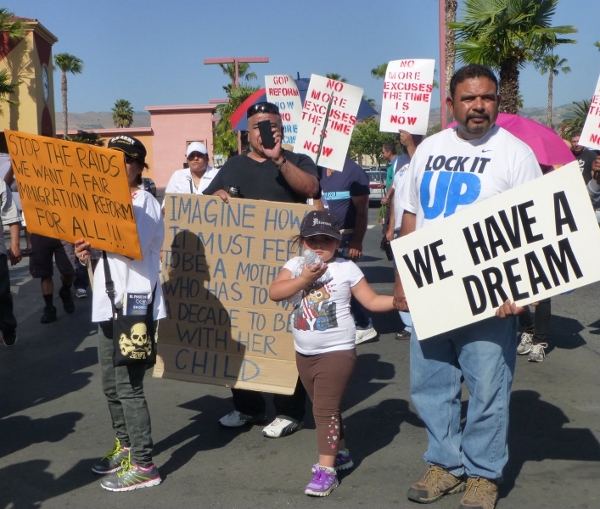
Photo/Joan Simon
SAN JOSE, CA — One of the largest May First immigrant-and-labor-rights marches in the country was in San Jose, California this year. As many as 20,000 people marched the three miles from the East Side to San Jose City Hall downtown.
The march was a success because every organization in the May 1 coalition worked hard to turn out their constituencies, friends, neighbors, co-workers, and fellow church members. They were unified under one voice behind three demands: the end of deportations and the unification of families, an immediate pathway to citizenship, and the respect of labor rights for all workers.
Marches represented a wide spectrum of people—day laborers, church groups, unions, community organizations, students and many members of the general public. There were Aztec dancers, a children’s drumming class, girls wearing dresses and aprons with slogans. Water was handed out all along the way, from supportive organizations, stores, and individuals.
The marchers brought hundreds of banners—there was a huge banner with the signatures of thousands of people by Voluntarios de la Comunidad; a banner with handprints, carried by a youth group from Guadalupe Church; banners announcing the presence of the Laborers Union, Sacred Heart Community Services, Unite HERE, Somos Mayfair, the United Food and Commercial Workers, American Federation of State, County and Municipal Employees (AFSCME), the Plumbers and Pipefitters, the Low-Income Self-Help Center, the Women’s International League for Peace and Freedom, and many more.
The United States has long been known as a country of immigrants. Currently immigrants make up about 13 percent of the population. One hundred years ago immigrants made up even more, 14 percent of the population.
California’s Santa Clara County, where San Jose is located, has one of the highest immigrant populations in the country. Indeed, San Jose’s population is estimated to be 10 percent undocumented. Two of every three residents are either immigrants or children of an immigrant.
However, there are many class differences among the immigrants—some are well educated and well off, coming to work in Silicon Valley as engineers from India, China, Taiwan, and Europe. Silicon Valley executives such as Facebook’s Mark Zuckerberg are fighting to keep these “desirable” immigrants in the country as a plentiful supply of technical workers without having to shore up the U.S. educational system.
Other immigrants have come to escape persecution, aggression, war, destruction of their lands and their ability to survive, precipitated by our military industrial complex.
Still more immigrants are at the bottom of the economic ladder, mostly from Mexico and Central and South America, but also the Philippines and other Pacific Islands, Africa, and Southeast Asia. Fleeing hunger in their homelands and often undocumented, many work for minimum wage or less.
These were the people taking to the streets in San Jose on May 1, fighting for the strongest possible immigration reform.
The march was organized by the May 1 Coalition, including AFSCME, Anakbayan, Californians for Justice, MAIZ, NAFCON, PAWIS, Sacred Heart Community Service Agency, Santa Clara County Building and Construction Trades Council, SEIU USSW, SIREN, SJPJC, SJSU SAHE, South Bay Dreamers, the South Bay Labor Council, UFCW Local 5, and the Voluntarios de la Comunidad.
